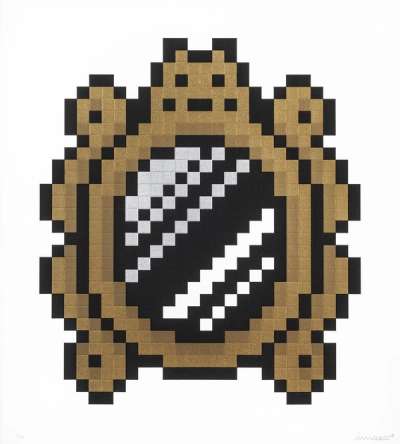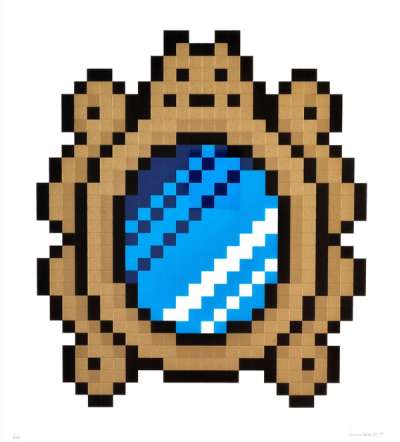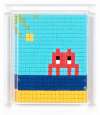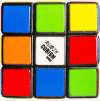Versailles
Designed for his Into the White Cube exhibition, Invader’s Versailles series translates architectural details of Versailles Palace into his signature 8-bit style. The print and the exhibition focused on the increasing acceptance of Street Art into the canon, not least through this parody of the widely recognisable French Landmark.
Invader Versailles For sale
Versailles Value (5 Years)
Invader's Versailles series has historically shown more modest results compared with the artist’s wider oeuvre, with auction prices ranging from £1456 to £4730. Average annual growth has remained modest at -0.84%, with certain works seeing declines in value. Over 21 total auction appearances, average selling prices have held steady around £3258. This series appeals to collectors seeking accessible entry points into Invader’s print market.
Versailles Market value
Auction Results
| Artwork | Auction Date | Auction House | Return to Seller | Hammer Price | Buyer Paid |
|---|---|---|---|---|---|
 Versailles (blue) Invader Signed Print | 26 Jan 2025 | SBI Art Auction | £1,530 | £1,800 | £2,150 |
 Versailles (black) Invader Signed Print | 7 Jul 2024 | SBI Art Auction | £1,190 | £1,400 | £1,700 |
Sell Your Art
with Us
with Us
Join Our Network of Collectors. Buy, Sell and Track Demand
Meaning & Analysis
Designed for his Into the White Cube exhibition, Invader’s Versaille series reflect the luxury palace at Versailles, but in his signature 8-bit style. The prints were designed by Invader specifically for one of his largest solo exhibitions,Into the White Cube, held at Over the Influence in Los Angeles, California, and were then placed on sale by the artist in a very limited set.
Playing on Brian O’ Doherty’s seminal 1976 essay, ‘Inside the White Cube: The Ideology of the Gallery Space’, a reflection on the politics of contemporary museums, the exhibition, and with it these prints attest to Invader’s ever-growing influence within the institutional art scenery. More importantly, they speak to how Street Art is increasingly accepted and recognised by official academic narratives as an art form that has earned its place within more traditional artistic traditions and which should be on a par with other traditional media. Following in the footsteps of Banksy’s artworks and the legacy he has built for Street Art, Invader’s exhibition re-establishes the mark that Street artists, through their often political statements, are leaving upon art historiographies.
Invader’s characters have thus taken over both the urban setting and the enclosed space of the gallery. The exhibition focused on highlighting Invader’s achievements throughout a timeframe of over two decades, exhibiting his iconic 8-bit mosaic video game characters and pop figures and a brand new series and media. The prints are bright, pop, irreverent and, most of all, unexpected. For the exhibition, Invader made sure to preserve the sense of fun and unexpectedness that characterises his street pieces, where the viewer is immersed in a real-life game or a treasure hunt. He did so, by covering an entire wall with over fifty new editions of his mosaics, spanning from representations of Where is Waldo to quotations of Super Mario. Regarding this twofold setting, which seemingly contradicts Street Art’s claims to visibility, accessibility and an anti-commodity ethos, Invader claims: ‘‘it is not easy to be good in both places. But it is not a paradox. I am an invader, I am a street artist, but I am also an artist’’.
The prints in this series represent two mirrors inspired by the luxury of the Palace of Versailles and are evocative of the palace’s most famous room, the Hall of Mirrors, which has come to stand for the opulence and elegance of Baroque art and architecture all over the world. Versailles is an important centre for the artist, who has invaded the city through what he terms multiple ‘Invasion waves’. At the moment, the city holds more than 42 public artworks and has been invaded over twelve times. While in these representations the city and the palace are only referenced, certainly the prints stage a dialogue with the other public artworks which the artist designed whilst thinking of the inspiring beauty of the French landmark.
Once again, Invader manages to create new, original and unexpected artworks in different media which are nevertheless always inscribed within his larger project of world invasion and his fascination with distinctive urban environments, as well as, of course, the digital world of video game characters.









